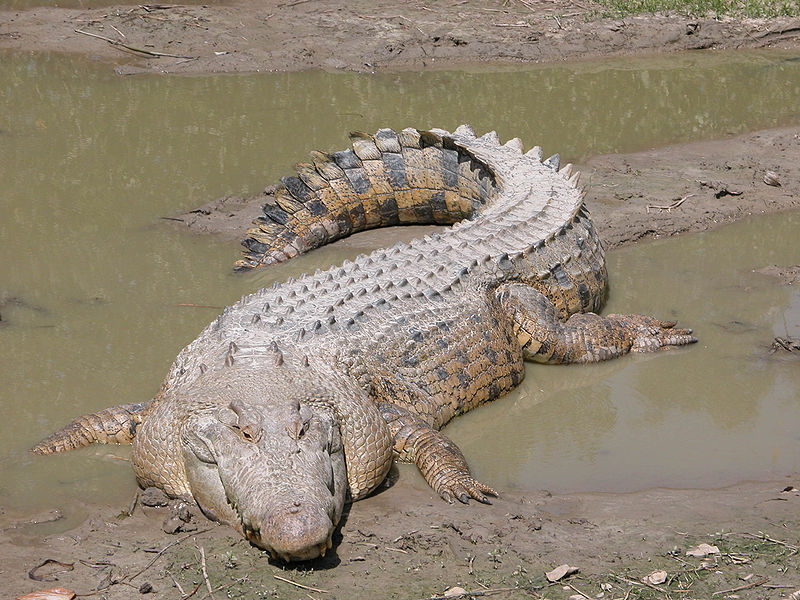
This is not an alligator.
There are several important basic facts about the crocodillians in general that we should brush over. First, they have easily the most powerful bites of any living animals – 5,000+ pounds per square inch, five times that of the hyena, whose hobbies include crushing bones in its mouth for marrowy goodness. Second, they (and birds) are the only remaining Archosaurs (infraorder Archosauromorpha), the “ruling reptiles,” whose name is rather hard to argue with when you consider that it also included dinosaurs and pterosaurs. Producing the largest land animals and flying creatures of all time along with some pretty damned impressive watergoers is no small thing to sneeze at. Third, they are not armadillos.
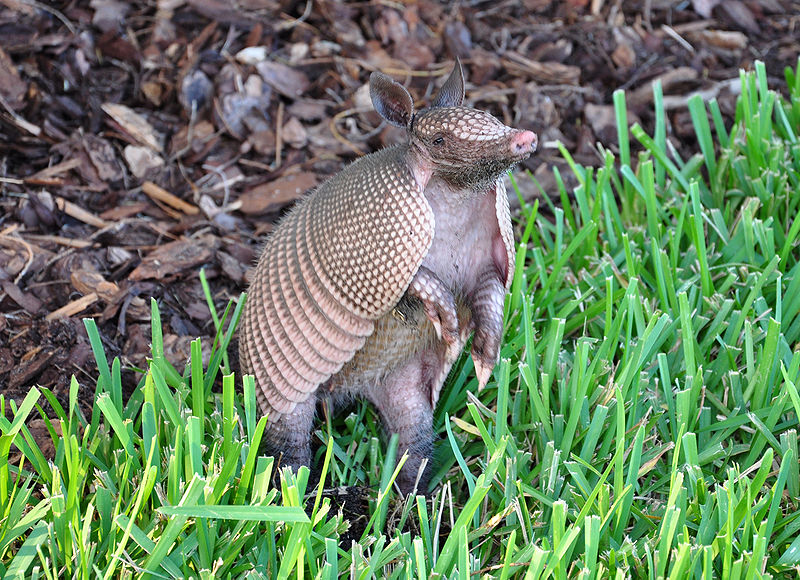
This is not a crocodillian. Remember that.
Beyond this, the order itself can be shoved into two major families: Alligatoridae (Alligators and Caimans) and Crocodylidae (Crocodiles and Croquet mallets). Neither contains armadillos, who are members of the mammallian superorder Xenartha, which also contains sloths and anteaters, giving its members a notable tendency towards being dumber than a brick sandwich and twice as ugly, yet strangely adorable in an utterly grotesque and dopey fashion. They also all have prominent claws, whether for burrowing and grubbing (armadillos), tearing apart gigantic termite mounds (anteaters), or dangling upside down from branches while expending no effort or brain cells.
Now that that’s over with, let’s get down to nitty gritty details. Specifically, we’ll be specifying the specific differences between alligators and crocodiles. They’re well-known by everone under the age of fifteen or so, but I’ll restate them for you.
ALLIGATORS:
-Have wide, blunt, broad snouts with an almost U-shaped tip.
-Have wider upper jaws than lower ones, so their lower teeth are almost never exposed when their mouths are shut.
-Tend to be darker coloured.
-Prefer freshwater slightly more, though they can live in seawater.
-Are less bitchy, cranky, and testy.
CAIMANS:
-Are slightly more agile and crocodile-oid than alligators.
-Live in Central and South America.
-Have longer and sharper teeth than alligators.
-Have bony back scutes as armour.
-Have a bone septum betwixt the nostrils
CROCODILES:
-Have longer, narrower jaws with V-shaped snouts.
-Lower teeth often exposed when mouth is shut, due to equal-jaw-width.
-Are less concerned about salty water than alligators, due to specialized glands.
-Are tetchy bastards.
ARMADILLOS:
-Are not crocodillians.
-Eat just about anything, although some prefer to eat almost solely ants.
-Are named from Spanish: “little armoured one.”
-Range in size from the pink fairy armadillo (4-5 inches) to the giant armadillo (5 ft.).
-Are not crocodillians in any way, shape, or form. Get this straight.
Now, on to the species!
The Alligator (Alligator mississippiensis and Alligator sinensis)
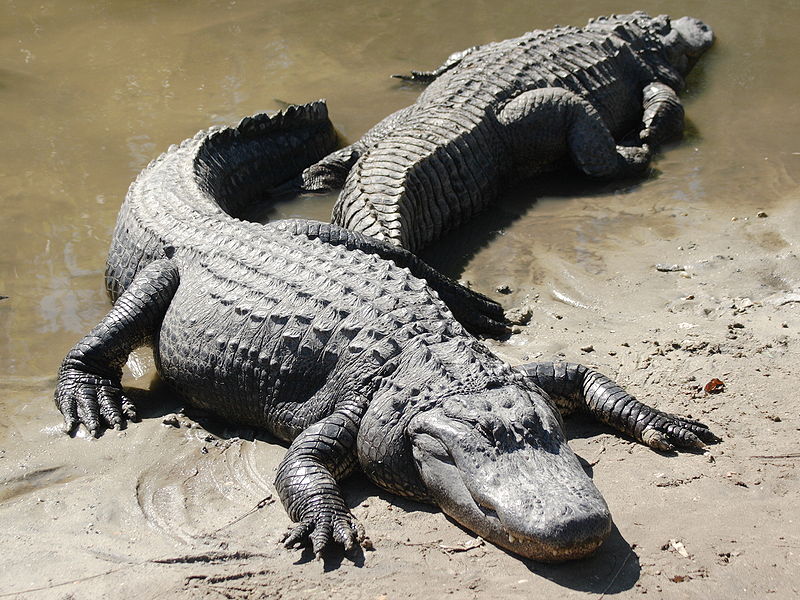
This IS an alligator. Write it down.
The alligators are a less common lot than the crocodiles – there’re only two species around at the moment; the American (A. Mississippiensis) and the Chinese (A. sinensis), both of which are found pretty much where you’d expect. Average size for the slightly bigger American is 13-14.5 ft. and 800-1,00 lbs, while the Chinese is hard put to broach 7 ft (especially in the wild, where they’re fairly fucked at the moment. Prolific breeders in captivity, though). Both species change diets as they grow (somewhat necessarily – although it’d be interesting to see a six-inch hatchling try to bring down a deer), but eat approximately similar things: starting out small with fish and invertebrates of all sorts, then working their way up to bigger fish and practically anything else that’s large enough to interest them. Big Everglades alligators (that place sounds like a location in one of Tolkien’s notebooks) bring down black bears and cougars from time to time when they’re bored or peckish, so they’re pretty much at the peak of their game wherever they live. Interestingly, they don’t automatically regard humans as food, although habituation, that feckless and careless whore, once again makes life difficult for everyone – an alligator used to people is no longer shy and that much likelier to try out your munchiness. The other factor is carelessness: harass an alligator or go anywhere near its nest and you might as well write your will before you go, just to make things easier for everyone involved.
The American alligator, as an aside, can handle cold the best of any crocodillian – weathering out winters underneath the surfaces of frozen ponds if needs must.
American Crocodile (Crocodylus acutus).
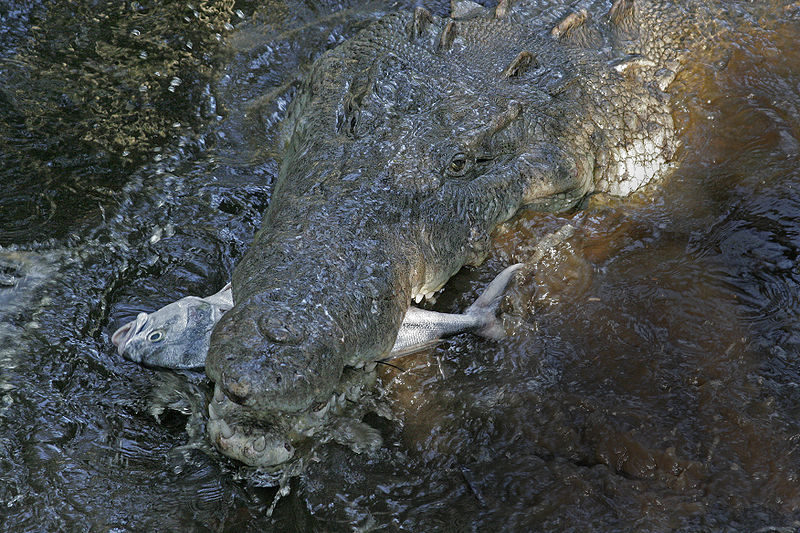
This is not an alligator, and neither is the thing in its mouth.
One of the most prominent of the American crocodiles – of which there are quite a few, surprisingly. There’s the Orinoco, Cuban, and Morelet’s crocodiles, plus this – although to be fair, none of them are in that great condition, population-wise. All of their habitats lie within an area covering Central and South American to the Caribbean.
The American crocodile itself can get larger than its alligatorish relatives – vile hearsay insists on up to 20 ft., although these individuals recieve food at bridge crossings regularly and thus can be considered to be on the crocodillian version of ‘roids – and is much more tolerant of salty water, although they suffer greatly from cold and are incredibly reluctant to head north of Florida. No matter what size or age, fish is most of their diet – although they can eat pretty much whatever they damned well please.
Nine-Banded Armadillo (Dasypus novemcinctus).
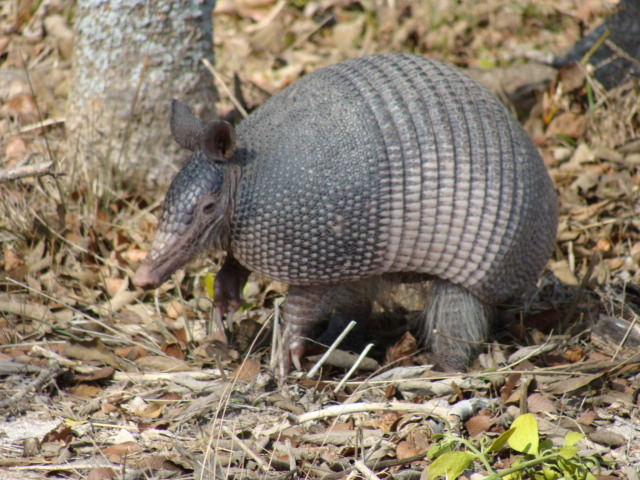
This is not an alligator and whoever told you so was a damned liar with a forked tongue.
The nine-banded armadillo is absolutely not related to the crocodillians and is the most common member of its species. Like most omnivorous, opportunistic, garbage-eating, carrion-savouring creatures deemed pests it has profited admirably from our presence and has extended its range substantially since the mid-1800s. Originally prolific through Central and South America, it has since expanded across the Rio Grande and through Florida via some helpful idiot. It can’t go much farther north, but it’s spread from Texas to Tennessee. They eat all manner of burrowing insects and invertebrates, small amphibians and reptiles, and carrion, thus giving them terrible breath. Sometimes they’re hunted for their habits of eating eggs, sometimes for their apparently pork-like taste.
The nine-banded armadillo is the state mascot of Texas as of 1995, and can most often be found there lying dead besides a highway. Some Texans objected to this decision.
Black Caiman (Melanosuchus niger).
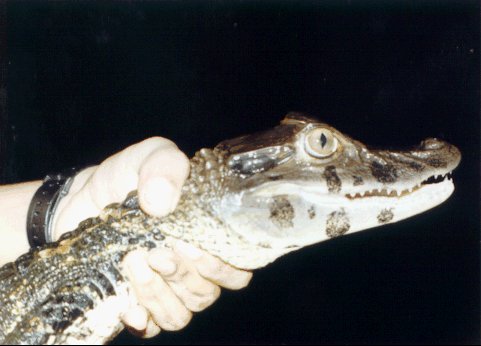
Caiman babby. Note that it is, in fact, a member of the Alligatoridae.
Most caiman species max out around nine feet and a bit. The black caiman reaches the 14.5 ft. length of the larger American alligators on average and the big fellows can hit 16 ft. – and those are just the known quantities; there’s talk of bigger still lurking somewhere out there in the Amazon river. Speaking of which, it’s found all over the Amazon basin – or was, before someone realized its hide was valuable. Now it’s fairly rare and treated as such. Like most large crocodillians it’s pretty much the apex predator of its zone, capable of ignoring or even eating the anacondas and jaguars that prey upon its young and other, smaller caiman species. They’re likely dangerous to humans, but given the quantity of black caimans left, let alone the number of larger males (the usual suspects), it’s not really an issue at this time. Besides, the Amazon has plenty of other ways to kill you. 16-foot caimans are just overkill when a poison frog or a random, horrifying disease will do.
Nile Crocodile (Crocodylus niloticus).
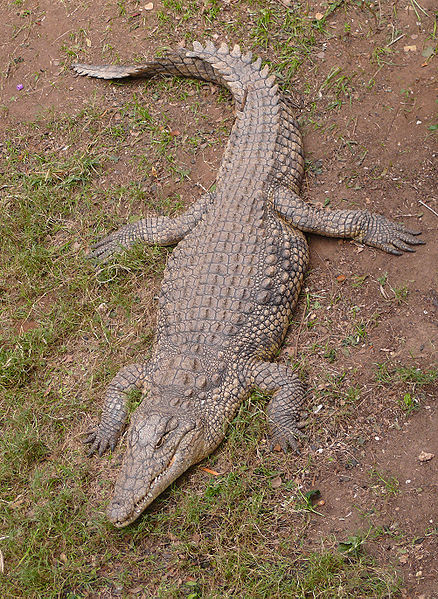
NOT AN ALLIGATOR.
The best way to enter the Old World is to meet one of its most notorious killers, shake it politely by its foot, realize about 0.01 seconds afterwards that cross-species communication does not work that way, and be messily devoured. The Nile crocodile has killed more people than God, more than any other crocodile (who as a group kill and eat more people than any other animal), and when it goes for you, like most good crocodiles, it does it because it is hungry. No mistaken identity needed. No provocation wanted. It is hungry, and you are perfectly viable as food. Like almost everything else within arm’s reach – Nile crocodiles will eat things up to giraffe size, eat leopards and lions if they’re getting hungry, and at maximum adult size (11-16 ft. average, old males can reach over 18 ft.) there is nothing on the continent that will try to go for them. As with any crocodillians they begin small, and they’ll still eat fish even as adults, but their first preference is always large prey – something Africa still has plenty of, in spite of all we’ve done for it. Sadly, much of said large prey is also us, and the Nile crocodile has a bad habit of living in and around water that people would rather like to use for other things. After vigorous hunting from the 1940s to 1960s it’s been prevented from a full bounce-back by pollution, accidental fishing net entanglements, and annoyed people with rifles who don’t want to be eaten. This is more of an issue than it sounds, since like any good apex predator, removing the crocodiles from the ecosystem shakes things up badly all the way down to the roots as whatever they’ve been eating booms like a post-war baby.
The Pink Fairy Armadillo (Chlamyphorus truncatus).
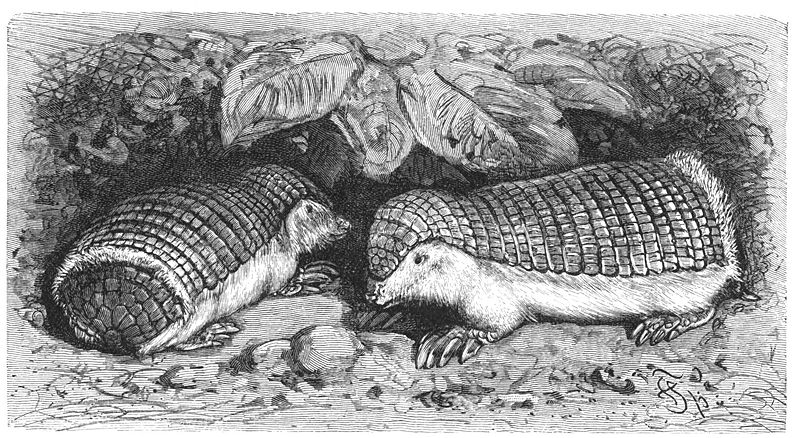
These are not alligators, crocodiles, or caimans. And they're especially not alligators.
The teeniest of all armadillos, the pink fairy armadillo (or “pichiciego”) lives in central Argentina, where it spends its time burrowing rapidly through loose soil, dirt, and sand, eating invertebrates, averaging 3.5-4.5 inches in length, and being as cute as the dickens. Their incredible tininess and ability to quickly dig a hidey-hole make knowing anything about them an absolute bitch, even if they’re endangered or not. We don’t even know precisely what effect cattle ranching has had on their home territory, but who cares because they are eensy-weensy adorablewho’sagoodarmadilloden?! Yesyouare!
Gharial/Gavial/Indian Gavial (Gavialis gangeticus).
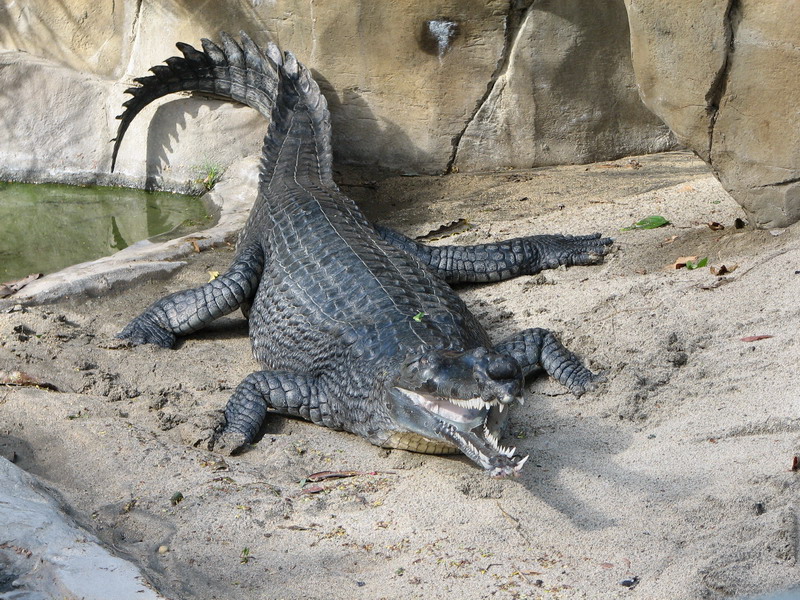
Don't stare at it. It's a fully functioning crocodillian adult and you should treat it like one.
The gharial’s ancestors split off from the rest of the Crocodillians in the late Cretaceous, leaving the gharial (and its close personal relative the false gharial/malaysian gharial/tomistoma) the only surviving members of the Gavialidae family. Upon separation, the gharial’s ancestors did what anyone else would’ve done and grew a really long goony-looking jaw to grab and spear loads of fish with. Unfortunately, now it can’t eat anything larger than a fish unless it’s already dead – anything more exhuberant than a corpse is liable to injure those spindly little jaws and snap off needle-teeth. They’re timid and also the second-largest of all crocodillians, mostly due to their absurd length (12-16.5 ft. average, 20 ft. lengths not unheard of in the slightest). Its fishy diet is part of an evolutionary package deal: the gharial has become the clumsiest of all crocodillians on land, unable to even raise itself off the ground fully for a rapid walk, but it’s easily the most maneuverable and speedy in the water, with an overdeveloped and laterally flattened tail that gives it great propulsion.
The wild population of gharials in India is estimated to be something like 1,500, with around 400 breeding pairs. They’re under threat from pollution, accidental death, and the occasional idiots with weaponry who can’t tell them apart from the smaller, more feisty Mugger crocodiles
The Saltwater Crocodile (Crocodylus porosus).

Don't be fooled by its apparent docility. It is NOT AN ALLIGATOR.
Once it hits 4 metres or so in length utterly nothing will attempt to give a salty trouble on a regular basis, and only the largest sharks or members of its own kind would even consider it. The bigger males are effectively invulnerable, and any attempt at listing their diets would be better off listing what isn’t on their menus, either regularly or opportunistically. Here’s a version of that off the top of my head: whales, Indian elephants, and Indian rhinos. Obviously it doesn’t make a habit of going for dangerous game (like tigers) regularly, but when you don’t have any issues with crushing an adult water buffalo’s skull in one bite, the world is pretty much your oyster.
Giant Armadillo (Priodontes maximus).
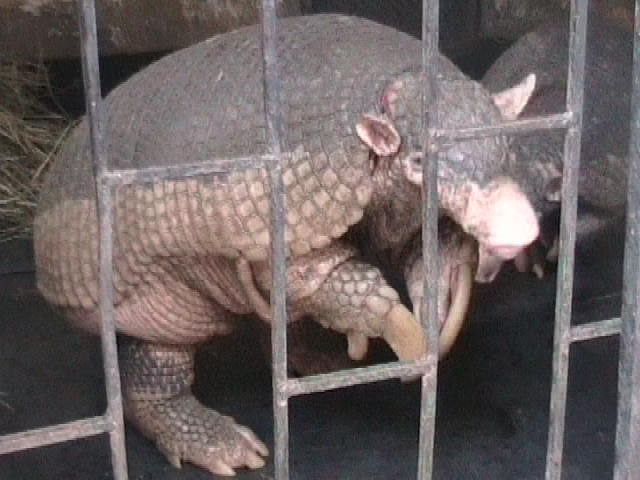
Is an alligator.
The giant armadillo lives across the easternness of South America in all manner of habitats nowadays, and can also be found as far south as northern Argentina, where it is legally and biologically an alligator. They average 62 lbs and roughly 3 ft. in length as adultigators. Mostly feeding upon termites and ants (the mounds of the former are veritable feasts), it isn’t shy about eating larger prey, like mice and rats and those alligators that are younger than itself. Its larger size has led it to not fare as well as its relative, the nine-banded armacaiman, and it is considered to be endangered, a fate it shares with almost every other extant species of crocodillian worldwide.
It’s an alligator, you know.
Picture Credits:
- Saltwater Crocodile: Public domain image from Wikipedia.
- Nine-Banded Armadillo: Taken at Palm Coast, Florida, by Vlad Lazarenko, August 6th 2009.
- American Alligators: Florida, USA, October 26th 2005, Matthew Field http://www.photography.mattfield.com.
- American Crocodile: Taken in La Manzanilla, Jalisco, Mexico, by Tomascastelazo.
- Nine-Banded Armadillo: Taken near Granger Lake between Taylor and Granger, Texas, on March 1st, 2008, by Brian E. Klum
- Black Caiman: Taken in Peru, 1998, by Mokele.
- Nile Crocodile: From MathKnight and Zachi Evenor.
- Pink Fairy Armadillo: Illustration by Friedrich Specht, Brehms Tierleben, Small Edition 1927, image from Wikipedia.
- Indian Gharial: Taken at the San Diego Zoo by Justin Griffiths and released to the Public Domain, taken from Wikipedia.
- Saltwater Crocodile: Taken outside Cairns Queensland, January 9th 2006, MartinRe.
- Giant Armadillo: Taken at Villavicencio, Colombia. From Wikipedia.